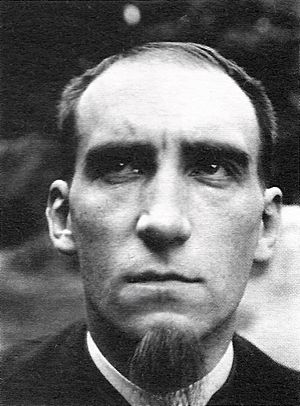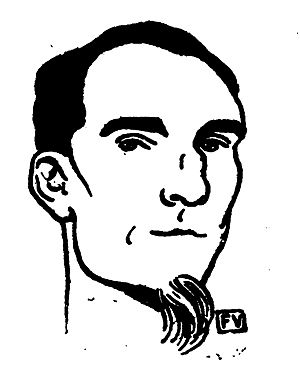Félix Fénéon facts for kids
Quick facts for kids
Félix Fénéon
|
|
|---|---|

Félix Fénéon, c. 1900
|
|
| Born | 22 June 1861 Turin, Italy
|
| Died | 29 February 1944 (aged 82) |
| Nationality | French |
| Occupation | art critic, art gallery director, writer |
| Signature | |
 |
|
Félix Fénéon (born June 22, 1861 – died February 29, 1944) was a French art critic, who wrote about art. He was also a gallery director and a writer. He lived during the late 1800s and early 1900s.
Fénéon was also involved with anarchism, a political idea where people believe society should exist without a government. He created the word Neo-Impressionism in 1886. This word described a new art style led by the artist Georges Seurat. Fénéon strongly supported these artists.
The Fénéon Prize is an award that was started in 1949. Félix's wife, Fanny Goubaux, created it. She used money from selling his art collection to fund the prize.
Early life and beginnings
Fénéon was born in Turin, Italy, in 1861. His mother, Marie-Louise Jacquin, was a Swiss schoolteacher. His father, Pierre Marie Jules Félix Fénéon, was a French salesman. Félix grew up in a region of France called Burgundy.
When he was 20, Fénéon moved to Paris. He had done very well in special exams for government jobs. He started working for the War Office, which was like a government department for military affairs. He eventually became a chief clerk there.
While working, he also edited many literary works. These included writings by famous authors like Rimbaud. He also helped the new Pointillist art movement grow. This movement was led by Georges Seurat. Fénéon often attended gatherings at the home of the poet Stéphane Mallarmé. He was also active in groups that supported anarchist ideas.
Political involvement

Fénéon worked at the War Office for 13 years. During this time, he was very active in supporting groups that believed in anarchism. In March 1892, French police started watching Fénéon. They thought he was an "active Anarchist."
In 1894, Fénéon was arrested. Police suspected him of being involved in a plot related to an incident at a restaurant. He was also thought to be connected to a serious event involving the French President, Sadi Carnot. Fénéon and twenty-nine other people were arrested. This became known as the Trial of the Thirty.
Fénéon was found not guilty, along with many others. The trial brought Fénéon a lot of public attention. He was usually a quiet person working behind the scenes. But during the trial, he showed his cleverness and wit, which amused the jury. The writer Julian Barnes described one moment: The judge asked Fénéon if he had been seen talking to someone known for anarchist views behind a gas lamp. Fénéon calmly replied, "Can you tell me, Monsieur le Président, which side of a gas lamp is its behind?"
A career in art and writing
After the trial, Fénéon became even more private. In 1890, the Neo-Impressionist artist Paul Signac wanted to paint a portrait of him. Fénéon refused several times before finally agreeing. He only agreed if Signac painted his full face.
Signac didn't paint him full-face. Instead, he painted a famous side view of Fénéon with his unique goatee beard. This picture became a well-known symbol for the anarchist movement. Many artists made their own versions of it. Even though Fénéon wasn't happy with it, he kept the painting on his wall until Signac died 45 years later.
Fénéon didn't publish many books. One of his most famous works is Novels in Three Lines. These were very short news stories, just three lines long. They first appeared in a Parisian newspaper called Le Matin in 1906. His girlfriend, Camille Pateel, collected them in an album. This is how they later became a book. When asked to publish them as a collection, Fénéon famously said, "I aspire only to silence."
As writer Lucy Sante points out, Fénéon is famous in a quiet way. He influenced a lot of things without being widely recognized by many people.
After the trial, Fénéon lost his job at the War Office. His lawyer, Thadée Natanson, offered him a job at a magazine called La Revue Blanche. He worked there until 1903. At the magazine, he continued to promote the art of Seurat and Signac. In 1900, he organized the first major show of Seurat's art. Seurat is famous for paintings like A Sunday Afternoon on the Island of La Grande Jatte. Hajo Düchting, who wrote a book about Seurat, said that Fénéon was the only art critic who truly understood and wrote well about Seurat's new painting style.
After La Revue Blanche closed, Fénéon worked for Le Matin newspaper. There, he wrote the short, three-line news stories called "faits-divers" (sundry events). He wrote them anonymously, meaning no one knew he was the author until the 1940s. In these short pieces, he captured the small, interesting details of French daily life. Here are some examples that show his clever writing:
- A tough woman named Mlle Tulle was sentenced to 10 years of hard work by the Rouen court. Her boyfriend received five years.
- In a café on Rue Fontaine, Vautour, Lenoir, and Atanis shot at each other a few times. They were arguing about their wives, who were not there.
- Women feeding their babies argued for workers' rights to the director of the streetcar lines in Toulon. He was not convinced.
After working at Le Matin, Fénéon became the director of the Galerie Bernheim-Jeune. This was an art gallery. He became even more involved with Neo-Impressionism, especially the art of Georges Seurat. He was the director of the gallery from 1906 to 1925. Before he retired from the gallery, he reportedly told a friend that he was "ready for idleness." He then suddenly quit at the age of 63.
Works
- Les Impressionnistes en 1886
- Œuvres; preface by Jean Paulhan, Paris, Gallimard, 1948
- Œuvres plus que complètes, 1970
- Novels in Three Lines (French: Nouvelles en trois lignes), translated and with an introduction by Luc Sante, 2007
- Correspondance de Fanny & Félix Fénéon avec Maximilien Luce, 2001
- Petit supplément aux œuvres plus que complètes, 2 volumes
- Le Procès des Trente, 2004
- Correspondance de Stéphane Mallarmé et Félix Fénéon, Maurice Imbert, editor, 2007
See also
 In Spanish: Félix Fénéon para niños
In Spanish: Félix Fénéon para niños


